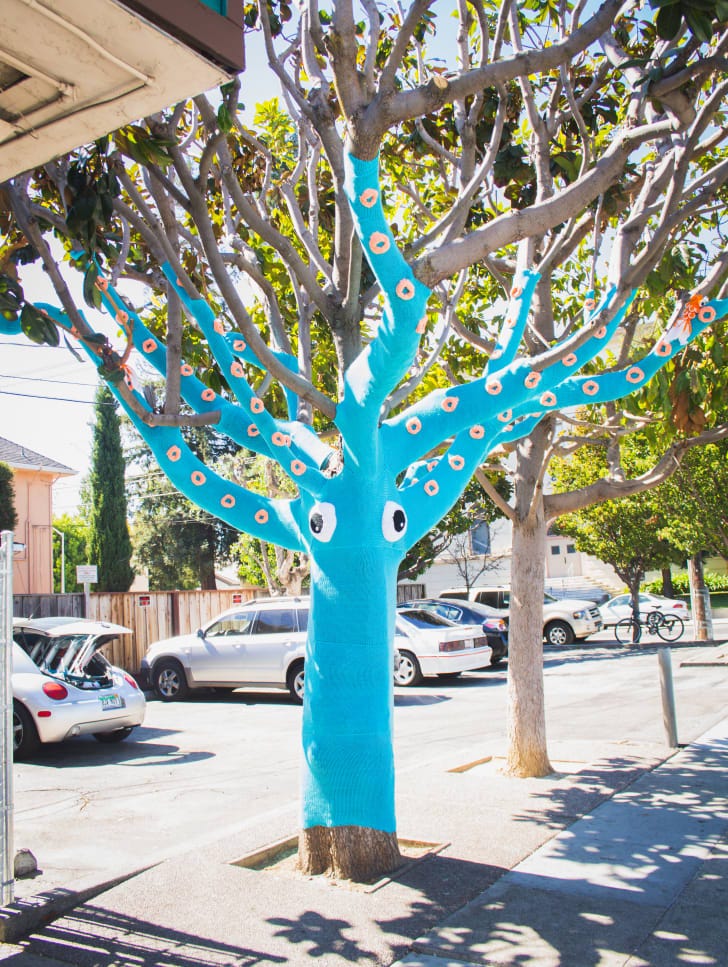#77 Design stitched up
Yarn bombing and cartwheel ruffs 🧶
This week we’re in a whimsical mood, as we explore some unusual examples of textile design. From activist knitting projects to a truly impractical piece of Tudor clothing, this is a Design Lobster you can get wrapped up in. 🦞
✨Enjoying Design Lobster? Please share it with a friend, colleague or fellow designer.
Question: What is yarnbombing?
Urban knitting or yarnbombing emerged as a public art form in California in the mid 2000’s. Urban knitters sought to bring a craft form more commonly associated with femininity and the home into public spaces and patriarchal institutions. Through techniques like knitting cozies for statues, benches and even trees, as well as forms of knitted mural attached to fences and railings, yarnbombers tag the city in a similar way to graffiti artists, adding personality and helping us see familiar things anew.
Yarnbombing is a legal grey area, and there have been valid criticisms that predominantly white and middle-class urban knitters gets away with activities that other more marginalised graffiti-creating groups are punished for. Environmental concerns about waste and pollution caused by synthetic fibres have also been raised. Nevertheless, I love the sheer whimsy of these knitted creations. I am struck especially by the literal softness of them, making nearly anything, including tanks, seem cuddly.
As a designer, I am always so grateful for things that refresh my vision of the world. In our job we are so often asked to to reimagine things and find hidden connections – these knitted sculptures show just how unexpected those connections can be.
Design takeaway: How could your design change the way we look at the world around us?
🧶 Watch an interview with urban knitter London Kaye.
Object: Cartwheel ruff
The ruff began life inconspicuously, as a small decorative ruffle in the collar of men’s shirts. By the sixteenth century it had grown enormous, with some examples of Dutch cartwheel ruffs requiring many metres of linen. These lengths were pleated in a figure of eight pattern in a practice known as goffering and then starched or even wired for further support.
It was the development of the then hi-tech starch industry in sixteenth century England that facilitated the ever-increasing size of these garments. Tudor nobility demonstrated their wealth with ever larger and more impractical ruffs, made from increasingly large quantities of expensive linen and lace. As a further demonstration of the wearer’s extravagance, each ruff was also pretty much single-use – body heat and weather caused them to sag and deform.
Eventually the item went out of fashion, replaced in the court of Charles I by a dropping lace collar known as a falling band. Collars have never really recovered the prominence that they had in sixteenth century clothing design, a relic of a much more formally-attired society.
Design takeaway: Could your design help people show off?
👗 Want more fashion stories? Design Lobster #58 explored an unusual Sixties clothing trend.
Quote: “Being creative is not so much the desire to do something, as the listening to that which wants to be done.”
– Anni Albers
We admired an extraordinary metallic textile that Anni Albers wove for her Bauhaus thesis project in Design Lobster #61. In this quote, which comes from her writings about weaving, she is describing how she responds to the unique qualities of different weaving materials. Nevertheless, I think it is more broadly applicable. I like the idea of a designer as a conduit, listening and interpreting rather than forcing themselves onto a situation.
Have a great week,
Ben 🦞
Enjoyed this week’s Design Lobster? Let me know by clicking the heart button.
👇



